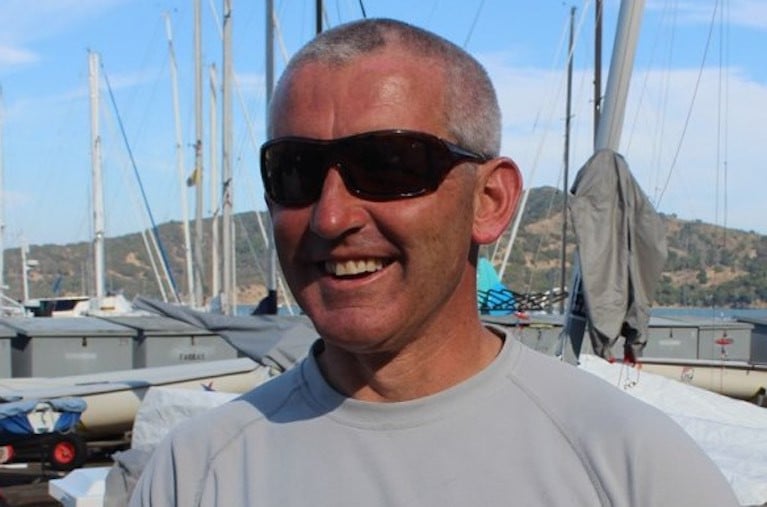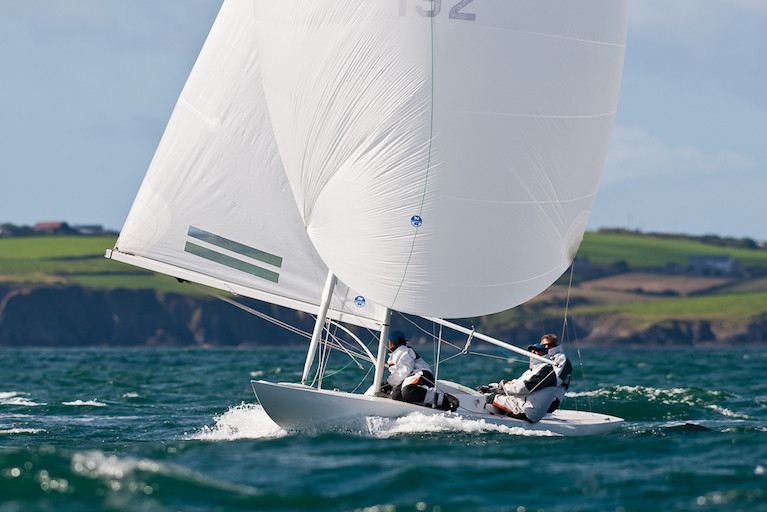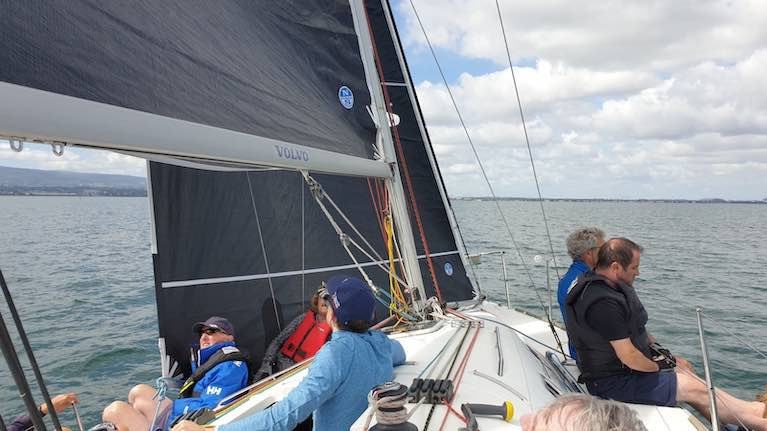Displaying items by tag: North Sails Ireland
North Sails & Professional Navigator Campbell Field Talk Through the New Rolex Fastnet Race 2021 Course
The biennial RORC Fastnet race is undergoing a seismic change this year. As reported here in Afloat, it's the first time since it's inauguration in 1925 that it will NOT finish in Plymouth in Devon but in Cherbourg in France.
As Afloat also reported, there are ten Irish boats entered for this year's race. The challenge will be new and quite different - certainly on the way back from "The Rock".
Here at North Sails, we have teamed up with professional navigator/weather router & Expedition/systems specialist Campbell Field to offer you a "Preparing For The Rolex Fastnet" webinar at 7 pm on Thursday 18th February 2021.
Campbell will be joined by our North Sails colleagues Ronan Grealish (originally from Galway, now based in Lymington) and Pete Redmond.
This is a "must-see and hear" for anybody who is serious about their offshore racing in 2021 and definitely for those planning to compete in the Fastnet!
Click here for more information and to register.
 Kenny Rumball and Pamela Lee will be competing in the Rolex Fastnet Race 2021 on their North Sails-powered Figaro 3 "RL Sailing"
Kenny Rumball and Pamela Lee will be competing in the Rolex Fastnet Race 2021 on their North Sails-powered Figaro 3 "RL Sailing"
From all of us here at North Sails Ireland, enjoy the webinar!
North Sails America's Cup "What is" Episode 2
Good Evening (or good morning!) sailors,
The first skirmishes in the Prada Cup finals are upon us and here at North Sails Ireland, we are watching with bated breath!
The protagonists are INEOS team UK skippered by...ahem.....2001 1720 European Champion (Sir) Ben Ainslie and....ahem.....Cork Week 2000 1720 competitor on "Atara" Jimmy Spithil in Luna Rossa Prada Pirelli.
Ben is a five-time Olympic medallist (four golds in the Finn and one silver in the laser) as well as a prior America's Cup winner with Oracle Team USA in San Francisco in 2013.
Luna Rossa Prada Pirelli co-skipper is Francesco Bruni, a treble Olympian and four times America's Cup veteran. His co-skipper Spithill is a double America's Cup winner himself.
All three remaining groups in the event (Emirates Team New Zealand, INEOS Team UK and Luna Rossa Prada Pirelli) are flying North Sails 3Di inventories. Tour team here at North Sails Ireland felt it would be useful to share with you the background, theory and practice of the twin-skinned mainsail that the AC 75 rule permits.
Please click here for a fascinating look at this (not new) concept but definitely new technology, brought to life by our amazing engineers and designers.
From the team here at North Sails Ireland - enjoy!
Full House for Prof’s Top Ten Dublin Bay Racing Tips at Royal Irish Yacht Club Webinar
North Sails Ireland’s Maurice “Prof” O’Connell’s top ten tips talk to RIYC Members and guests pulled in the crowds with a record-breaking 105 attending.
Prof’s insights for racing in Dublin Bay ranged on how to gain maximum advantage through adequate preparation before going afloat, through to the start line to sail trim principles/set-up and key boat handling manoeuvres for rounding marks.
Prof brought the audience through Dublin Bay geography and topography, the DBSC course card design, logic, mark locations and geometry as well as Dublin Bay currents.
He talked through the importance of correct onboard communications and providing clear information fundamental to sailing the correct course.
Prof, who never misses a DBSC race with his customers unless he is out of the country, concluded with “Rules of Thumb” for Dublin Bay racers. The talk was part of the RIYC “Home Together” series of virtual talks.
North Sails Series: 'What is Foiling & How Does it Work?'
Greetings and a belated happy new year everybody from the team here at North Sails Ireland.
Sailors all over the world are GLUED to two events right now - the Vendee Globe competitors hammering up from the south Atlantic and the extraordinary events at the America's Cup in Auckland New Zealand. Like all of us, our hearts were in our mouths for a few awful minutes last weekend when we witnessed the shattering capsize on American Magic and the immediate aftermath. They will be back on the water very soon and we wish their team the very best.
Big shout out to West Cork's Revelin Minihane who I saw, on my screen at four or five a.m. last Sunday morning, skillfully skippering American Magic's "chase boat" firstly into a rescue/safety position, then into the towing position to assist the boat in getting upright, then for the long assist in helping the boat stabilise and finally for what must have been a tortuous tow back (with American Magic facing backwards to minimise water ingress) to the dock in Auckland. Maith an fear Rev.
Our Newest Series Answers the Complex Questions Around the 36th America’s Cup
This first one is........"what is foiling and how does it work?"
So, click here and enjoy.............standing by at 3.20 a.m. in Dun Laoghaire, AP flag hoisted at 4.20 pm in Auckland!
America's Cup World Series - JB Braun's First Impressions
Season's greetings everyone!
The "trickle-down" effect is well known in other industries, and sailmaking is no different.
Just before Christmas, North Sails Ireland attended our North Technology Group global virtual conference for our team members and affiliates around the world. It was a wonderful opportunity for us to get together virtually and learn about the fascinating developments in all the NTG companies with North Sails at its core.
We listened to a gripping presentation from our Head Of Design and Engineering JB Braun, currently in New Zealand for the America's Cup. "JB" joined NS in 1999 and has been involved in six America's Cups.
Click on the link here to hear from JB describe his impressions of the recent America's Cup World Series, the technical developments in the "engine above the deck" and what it might mean for the broader sailing community...
Andrew Craig's J109 "Chimaera" Powered by North Sails 3Di & A GRADE Contender Spinnakers
Andrew Craig had been a leading competitor in the Dragon class in for many years. As well as competing in the championship circuit in Ireland, "Chimaera" has represented Ireland overseas at many European and World Championship events. It was in Hobart, in 2003, whilst coaching the Irish Mirror team at the Worlds there, that I first met Andrew who was racing at that time with the late Graham Elmes and Klaus Hoj-Jensen.
Over the past decade or so, occasionally, one of his trusted teammates Mark Pettit or Brian "Matty" Mathews were unavailable for the odd event so I was fortunate enough to stand at various times in Dublin Bay, Glandore, Belfast Lough and Cowes in the UK. His Dragon "Chimaera" was powered by North Sails' world championship-winning one-design sails, so, when he made the switch to the J109 class in late 2016 for the new "Chimaera", we were delighted to continue our involvement with Andrew and his great team.
Once the switch to North Sails had been made on the J109, the results started coming FAST.............
 "Chimaera" flying her 3Di RAW mainsail and Code 1 jib Photo: Maurice O'Connell / North Sails Ireland
"Chimaera" flying her 3Di RAW mainsail and Code 1 jib Photo: Maurice O'Connell / North Sails Ireland
In the one-design J109 fleet, two podium finishes at the 2017 and 2018 National Championships in Howth and Dublin Bay were achieved. Then in 2019, under IRC, "Chimaera" won her class and "Boat Of the Week" at the 2019 Scottish series. During this year's truncated season, she also won the National YC 150th centenary regatta in August.
North Sails powers "Chimaera" using 3Di RAW 780 upwind sails and downwind she flies asymmetric spinnakers manufactured in Contender A GRADE Superkote.
To read more about the "Chimaera" success story, click here.
North Sails Black Friday Deal Ends Monday, Nov 30
Dear One Design Sailors
We have been booking lots of orders on the Black Friday deal and we wanted to remind you that this offer ends on Monday the 30th Nov.
This is your very last opportunity to make a nice saving on the World's Fastest One Design Sails in 2020.....If you are in the market please do not hesitate to call us.
If you have been promising yourself an early Christmas present then now is the time!
Check out the link here for more info request a quotation or a call back.
Sail FAST
From your Team at North Sails Ireland
North Sails Ireland 2020 Victory List is Here!
Greeting sailors from North Sails Ireland. It's too early to say "seasons greetings" but we're not far off it!
Much has been written about 2020 to date. So let's add to it by reflecting on and acknowledging the wonderful achievements of our customers in this, the strangest of sailing years.
Our fantastic clients flew a huge range of North Sails products this year to power themselves to victory. At the top of each class, inshore, offshore and one-design, we saw winners flying everything from 3DI RAW to cross-cut NPC NorDac (North Dacron), from Helix cabless load-sharing Code Zero's and flying jib tops to little Norlon (North Nylon) symmetrics, on boats ranging from Water Wag dinghies to the largest Cruisers 0 IRC offshore race boats - and almost everything in between.
 DBSC winner 'White Mischief' flying her 3Di Main and Code 1 Jib Photo: Maurice O'Connell/North Sails
DBSC winner 'White Mischief' flying her 3Di Main and Code 1 Jib Photo: Maurice O'Connell/North Sails
What was especially gratifying was the podium performances of many of our customers who were flying North Sails products that were many seasons old - a sure testament to the longevity, durability and true long-term value that North Sails delivers.
It was a big move for us organisationally too, with my colleague Shane Hughes taking over the NS Ireland service operation. Shane started with NS in 1998 and is a vastly experienced sailmaker, as well as being a top sailor too. It is fair to say that his new loft in Wicklow has been a "game-changer".
 Maurice 'Prof' O'Connell of North Sails Ireland setting up the 3Di's onboard Mustang 30 'Peridot'
Maurice 'Prof' O'Connell of North Sails Ireland setting up the 3Di's onboard Mustang 30 'Peridot'
Nigel, Shane and I have been on the water all over the country in our short season, supporting our clients. When you need us, we are here and we love to talk boats! So do pick up the phone for a chat or email us anytime to see how we can help make you go FASTer for LONGER.
Please click on the link below to see our 2020 Victory List and HUGE congratulations to all sailors for your efforts this year around the country.
2020 North Sails Ireland Victory List here
Denis Byrne & 3Di Powered 'Cracker' Take Home the Royal Cork Trophies
North Sails 3Di is leading the way on more and more race winners in Ireland. Working with Royal Cork's Denis Byrne and the crew of the Trapper T250 Cracker has been a rewarding experience watching the crew develop and improve over time.
In 2019, Cracker won the Royal Cork Yacht Club’s 'boat of the year' award.
“It is unusual for a small boat like Cracker to win such an award in the biggest yacht club in the country,” said a proud Denis. In 2020 with the same inventory, he’s continued his winning streak. Cracker took her class and the overall win in the annual Cove to Blackrock Race, winning the coveted Moonduster trophy.
 Royal Cork's Darragh Connolly (left) presents the 'Moonduster' award to Cracker skipper Denis Byrne
Royal Cork's Darragh Connolly (left) presents the 'Moonduster' award to Cracker skipper Denis Byrne
I keep talking about the trickle-down effect from the largest Super Yachts down to the smaller Club racers......3Di has all angles covered.
This is another great example of a real-life trickle-down tale. Read more about Cracker's success here
Sail FAST into 2021
North Sails Feature The Women of the Vendée Globe Race
This year's Vendee Globe is going to be a fascinating race to follow. North Sails have been working with the IMOCA Class for many years now and all of the hard work and effort is paying dividends with seventeen of the boats being 100% North Sails and another eight boats with one or more North Sails in the inventory.
It all started back in 2001 when Bruno Dubois the manager of North Sails France worked on the sails with Dame Ellen MacArthur and her IMOCA 60 Kingfisher, in that race North Sails only had one or two boats using our products.
Great to see the 3Di product dominating the class and amazing to think that most of the North Clients in the race are using our top tier race product 3Di RAW looking for the fastest lap of the planet.
This is the same 3Di RAW product that has become so popular in the Irish Race market and has dominated the results in Ireland for many years now.
Episode 5 - The Women of the Vendée Globe
A record of six women is included on the 33 skipper roster for the Vendée Globe 2020. This is historic, considering only seven women have participated, and six have ever completed the race since its inception in 1989. This trend is a reflection of what we’re seeing elsewhere in sailing, as more women take on leadership positions and compete at the highest level of the sport.
See Episode Five in the North Sails Vendee Globe Series below.
Not long to wait for the start.....





































































